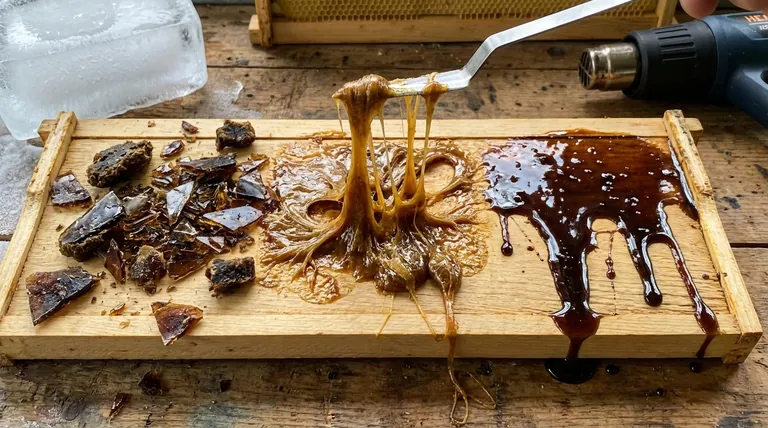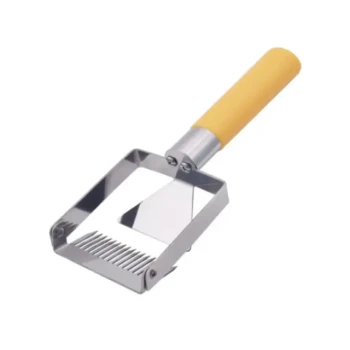In short, temperature dramatically transforms the physical state of propolis. This natural resin transitions from a hard, brittle solid in the cold to a tacky, pliable material when warm, and ultimately becomes a viscous liquid in extreme heat. Its behavior is highly dependent on ambient thermal conditions.
The core principle to understand is that propolis does not have a single, fixed state. Instead, it exists on a spectrum from glass-like to liquid, and you can control its physical properties for collection or application simply by managing its temperature.

The Three States of Propolis: A Temperature-Driven Transformation
Propolis is a complex mixture of resins, waxes, and other botanical compounds. This composition means it doesn't have a sharp melting point like ice, but rather softens and liquefies gradually as heat increases.
The Cold State: Brittle and Glass-Like
When cold, propolis becomes extremely hard and brittle.
The references describe it as shattering "like bone china" or snapping "like glass," yielding sharp shards. In this state, it loses all its stickiness and pliability.
This is often the ideal state for harvesting, as it can be easily scraped or chipped away from hive frames and boxes in solid pieces.
The Warm State: Pliable and Tacky
As the temperature rises, propolis softens significantly, becoming gooey and highly adhesive.
It is often compared to "fresh-from-the-oven mozzarella cheese," capable of being stretched into long, fragrant tendrils. This is its most common state within an active beehive on a warm day.
In this pliable form, bees use it effectively to seal cracks, smooth surfaces, and defend the hive. However, for a beekeeper, this stickiness can gum up tools and be difficult to handle cleanly.
The Hot State: A Viscous Liquid
In periods of intense heat, propolis will fully liquefy.
During "especially hot seasons," it can "run like water" down the interior walls of a hive. As it cools from this liquid state, it hardens into translucent droplets.
This behavior demonstrates its thermoplastic nature, transitioning from a solid to a liquid and back again based on temperature changes.
Practical Implications for Handling Propolis
Understanding these states is critical for anyone working with propolis, from beekeepers to artisans. The same material can be either a tool or a nuisance depending on the temperature.
Harvesting Challenges
Harvesting propolis on a very warm day can be a messy, frustrating task due to its extreme tackiness.
Conversely, harvesting on a cool day makes it easy to snap the brittle material off hive components. Chilling frames or propolis traps can artificially create this ideal brittle state for easier collection.
Storage Considerations
Storing raw propolis requires temperature control. If left in a warm environment, it can soften and fuse into a single, unmanageable mass.
For long-term storage and to maintain its integrity, keeping propolis cool or frozen is the most effective strategy. This preserves its solid form and makes it easier to break into smaller pieces for processing.
How to Manage Propolis Based on Your Goal
Your approach to handling propolis should be dictated by the temperature and your desired outcome.
- If your primary focus is clean harvesting: Work on a cool day or intentionally chill hive components to make the propolis brittle and easy to snap or scrape off.
- If your primary focus is application or molding: Gently warm the propolis until it becomes pliable and tacky, allowing you to work with it like a natural putty or sealant.
- If your primary focus is avoiding contamination: Be cautious on extremely hot days, as liquefied propolis can flow into and coat areas of the hive where it is not wanted.
Ultimately, mastering propolis is simply a matter of controlling its temperature to achieve the desired physical state for your task.
Summary Table:
| Temperature State | Physical Properties | Handling & Use Case |
|---|---|---|
| Cold | Hard, brittle, glass-like | Ideal for clean harvesting (snaps/scrapes easily) |
| Warm | Pliable, tacky, adhesive | Bees use it to seal cracks; can be molded for application |
| Hot | Viscous liquid | Can run and contaminate; hardens into droplets on cooling |
Struggling with sticky propolis? Let HONESTBEE supply your apiary with the right tools.
Managing propolis efficiently requires the right equipment, whether you're a commercial beekeeper or a distributor. HONESTBEE specializes in wholesale beekeeping supplies designed to handle all states of propolis—from durable scrapers for brittle propolis to temperature-controlled storage solutions.
We help you:
- Harvest cleaner and faster with tools optimized for different propolis states.
- Store propolis effectively to maintain quality and avoid contamination.
- Scale your operations with reliable, wholesale-focused equipment.
Ready to simplify your propolis management? Contact our team today to discuss your specific needs and explore our full product range.
Visual Guide

Related Products
- HONESTBEE Professional Long Handled Hive Tool with Precision Cutting Blade
- Professional Dual-End Stainless Steel Hive Tool for Beekeeping
- Stainless Steel Pivoting Honey Uncapping Fork with Plastic Handle
- All-Stainless Steel Pivoting Honey Uncapping Fork for Beekeeping
- Extra Wide Stainless Steel Honey Uncapping Fork with Scraper Beekeeping Tool
People Also Ask
- What tools are used for cleaning frames? A Beekeeper's Simple 4-Tool Guide
- What is a hive tool used for in beekeeping? Your Essential Guide to Hive Management
- What are the basic tools for beekeeping? Essential Starter Kit for Safe & Successful Hive Management
- What is the hive tool used for? The Essential Multi-Tool for Every Beekeeper
- How should beekeepers handle bees when using a hive tool? Master Calm, Deliberate Techniques



















